EEP417 Assignment: Ethical Dilemma of Sleep in Early Childhood Setting
VerifiedAdded on 2023/06/05
|11
|2946
|321
Essay
AI Summary
This essay addresses an ethical dilemma faced in early childhood education, focusing on a child's sleep schedule and the conflicting interests of the child, parents, and educators. The essay examines the legal aspects, professional considerations, and ethical principles involved, including references to the UNCRC, ECA moral codes, EYLF, and NQS. The author explores the complexities of balancing the child's need for sleep with parental concerns and the educator's responsibilities. The analysis includes the roles of key players, such as the child, instructors, and parents, and discusses the importance of establishing strong relationships with children and considering their needs. The essay considers relevant theories and proposes a meeting to find a common ground, emphasizing the need for compromise and understanding among all parties involved. It concludes by reiterating the importance of reevaluating sleep practices in early childhood settings to meet the child's basic needs while addressing the concerns of parents and adhering to ethical and legal guidelines.
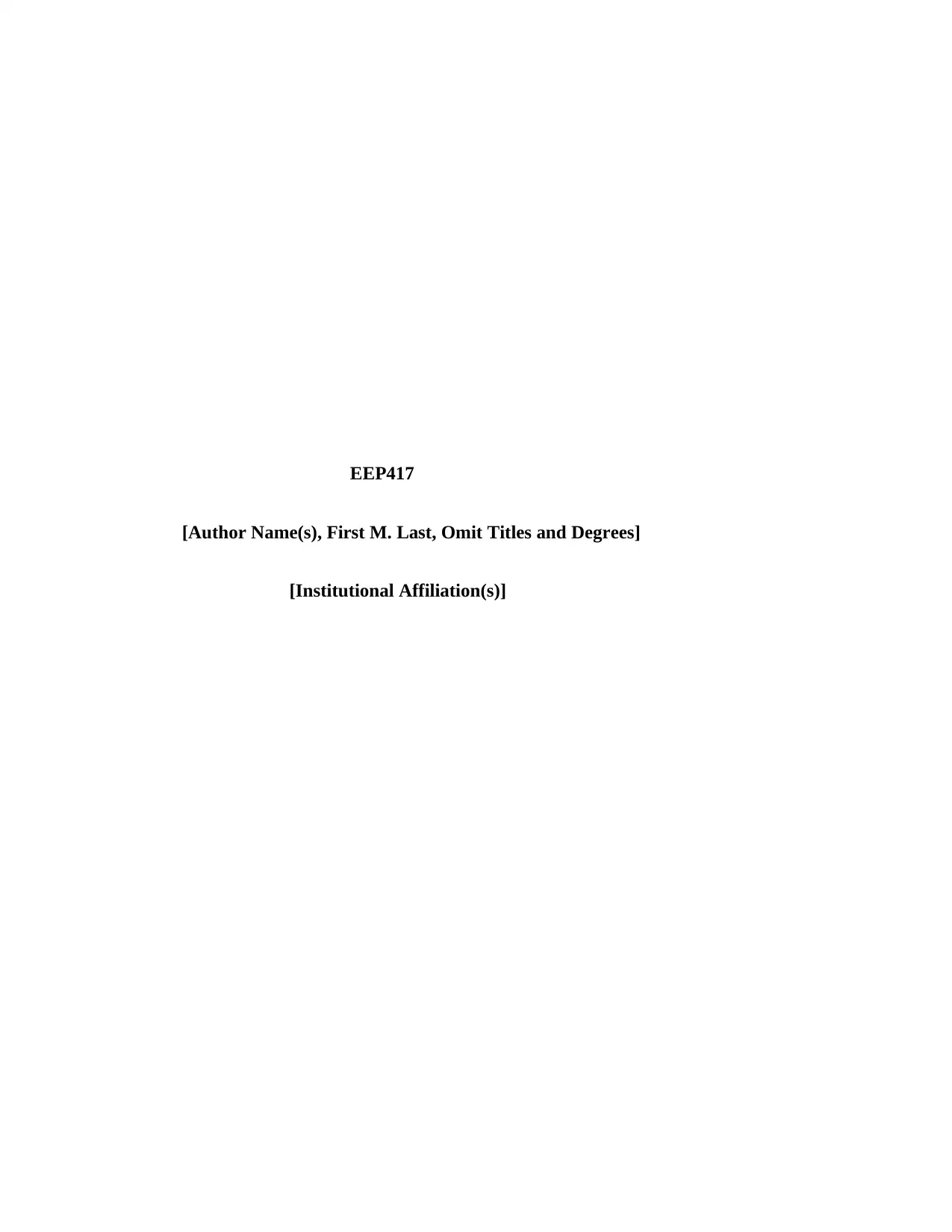
EEP417
[Author Name(s), First M. Last, Omit Titles and Degrees]
[Institutional Affiliation(s)]
[Author Name(s), First M. Last, Omit Titles and Degrees]
[Institutional Affiliation(s)]
Paraphrase This Document
Need a fresh take? Get an instant paraphrase of this document with our AI Paraphraser
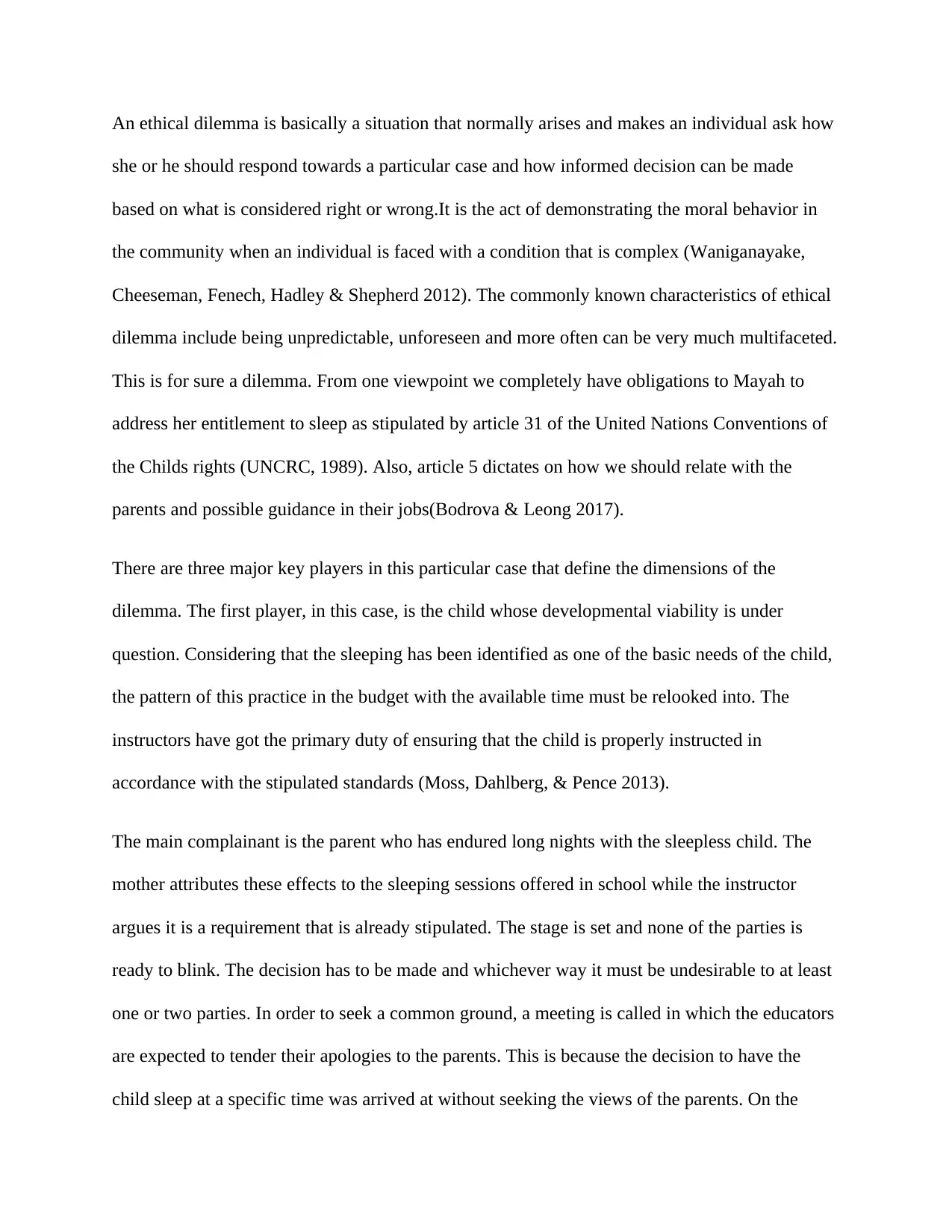
An ethical dilemma is basically a situation that normally arises and makes an individual ask how
she or he should respond towards a particular case and how informed decision can be made
based on what is considered right or wrong.It is the act of demonstrating the moral behavior in
the community when an individual is faced with a condition that is complex (Waniganayake,
Cheeseman, Fenech, Hadley & Shepherd 2012). The commonly known characteristics of ethical
dilemma include being unpredictable, unforeseen and more often can be very much multifaceted.
This is for sure a dilemma. From one viewpoint we completely have obligations to Mayah to
address her entitlement to sleep as stipulated by article 31 of the United Nations Conventions of
the Childs rights (UNCRC, 1989). Also, article 5 dictates on how we should relate with the
parents and possible guidance in their jobs(Bodrova & Leong 2017).
There are three major key players in this particular case that define the dimensions of the
dilemma. The first player, in this case, is the child whose developmental viability is under
question. Considering that the sleeping has been identified as one of the basic needs of the child,
the pattern of this practice in the budget with the available time must be relooked into. The
instructors have got the primary duty of ensuring that the child is properly instructed in
accordance with the stipulated standards (Moss, Dahlberg, & Pence 2013).
The main complainant is the parent who has endured long nights with the sleepless child. The
mother attributes these effects to the sleeping sessions offered in school while the instructor
argues it is a requirement that is already stipulated. The stage is set and none of the parties is
ready to blink. The decision has to be made and whichever way it must be undesirable to at least
one or two parties. In order to seek a common ground, a meeting is called in which the educators
are expected to tender their apologies to the parents. This is because the decision to have the
child sleep at a specific time was arrived at without seeking the views of the parents. On the
she or he should respond towards a particular case and how informed decision can be made
based on what is considered right or wrong.It is the act of demonstrating the moral behavior in
the community when an individual is faced with a condition that is complex (Waniganayake,
Cheeseman, Fenech, Hadley & Shepherd 2012). The commonly known characteristics of ethical
dilemma include being unpredictable, unforeseen and more often can be very much multifaceted.
This is for sure a dilemma. From one viewpoint we completely have obligations to Mayah to
address her entitlement to sleep as stipulated by article 31 of the United Nations Conventions of
the Childs rights (UNCRC, 1989). Also, article 5 dictates on how we should relate with the
parents and possible guidance in their jobs(Bodrova & Leong 2017).
There are three major key players in this particular case that define the dimensions of the
dilemma. The first player, in this case, is the child whose developmental viability is under
question. Considering that the sleeping has been identified as one of the basic needs of the child,
the pattern of this practice in the budget with the available time must be relooked into. The
instructors have got the primary duty of ensuring that the child is properly instructed in
accordance with the stipulated standards (Moss, Dahlberg, & Pence 2013).
The main complainant is the parent who has endured long nights with the sleepless child. The
mother attributes these effects to the sleeping sessions offered in school while the instructor
argues it is a requirement that is already stipulated. The stage is set and none of the parties is
ready to blink. The decision has to be made and whichever way it must be undesirable to at least
one or two parties. In order to seek a common ground, a meeting is called in which the educators
are expected to tender their apologies to the parents. This is because the decision to have the
child sleep at a specific time was arrived at without seeking the views of the parents. On the
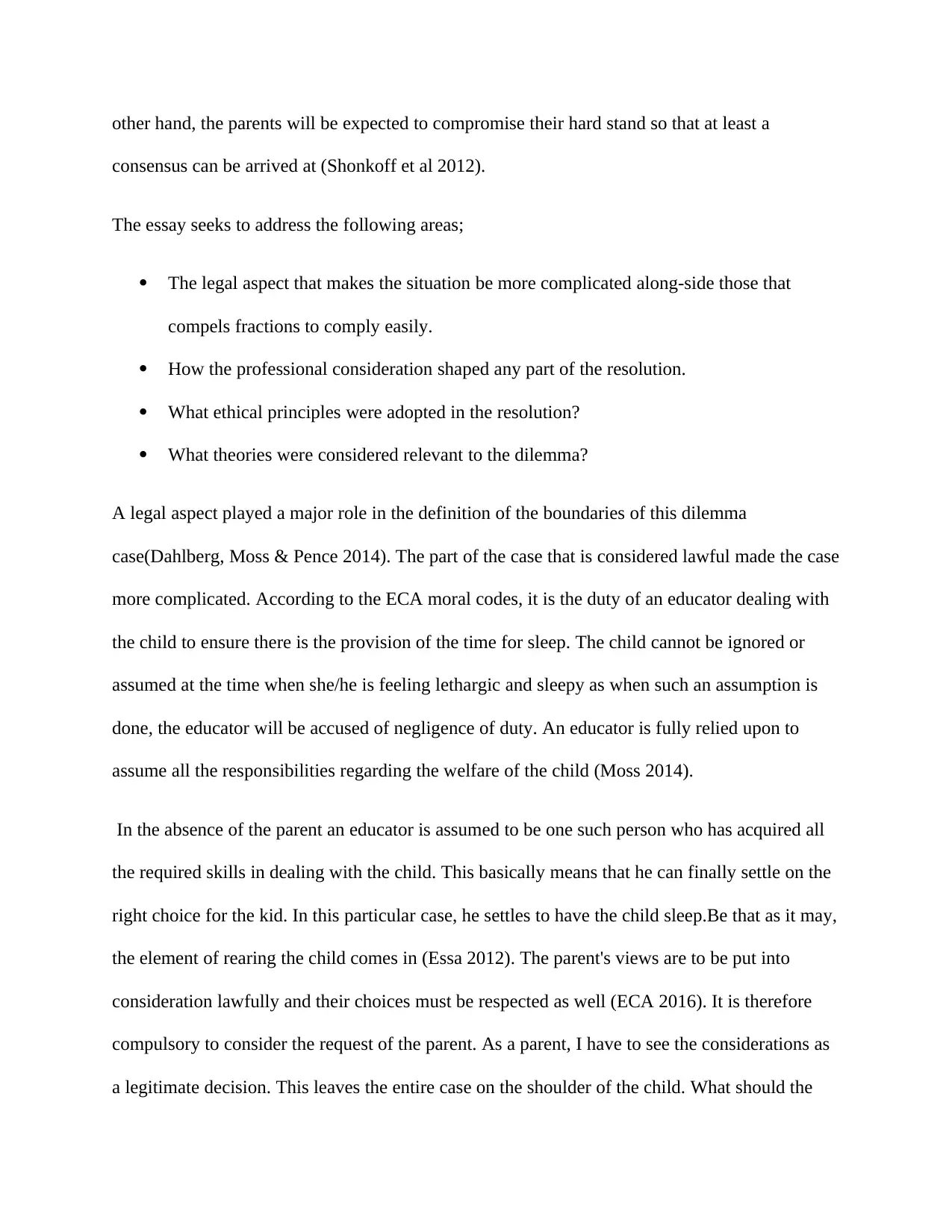
other hand, the parents will be expected to compromise their hard stand so that at least a
consensus can be arrived at (Shonkoff et al 2012).
The essay seeks to address the following areas;
The legal aspect that makes the situation be more complicated along-side those that
compels fractions to comply easily.
How the professional consideration shaped any part of the resolution.
What ethical principles were adopted in the resolution?
What theories were considered relevant to the dilemma?
A legal aspect played a major role in the definition of the boundaries of this dilemma
case(Dahlberg, Moss & Pence 2014). The part of the case that is considered lawful made the case
more complicated. According to the ECA moral codes, it is the duty of an educator dealing with
the child to ensure there is the provision of the time for sleep. The child cannot be ignored or
assumed at the time when she/he is feeling lethargic and sleepy as when such an assumption is
done, the educator will be accused of negligence of duty. An educator is fully relied upon to
assume all the responsibilities regarding the welfare of the child (Moss 2014).
In the absence of the parent an educator is assumed to be one such person who has acquired all
the required skills in dealing with the child. This basically means that he can finally settle on the
right choice for the kid. In this particular case, he settles to have the child sleep.Be that as it may,
the element of rearing the child comes in (Essa 2012). The parent's views are to be put into
consideration lawfully and their choices must be respected as well (ECA 2016). It is therefore
compulsory to consider the request of the parent. As a parent, I have to see the considerations as
a legitimate decision. This leaves the entire case on the shoulder of the child. What should the
consensus can be arrived at (Shonkoff et al 2012).
The essay seeks to address the following areas;
The legal aspect that makes the situation be more complicated along-side those that
compels fractions to comply easily.
How the professional consideration shaped any part of the resolution.
What ethical principles were adopted in the resolution?
What theories were considered relevant to the dilemma?
A legal aspect played a major role in the definition of the boundaries of this dilemma
case(Dahlberg, Moss & Pence 2014). The part of the case that is considered lawful made the case
more complicated. According to the ECA moral codes, it is the duty of an educator dealing with
the child to ensure there is the provision of the time for sleep. The child cannot be ignored or
assumed at the time when she/he is feeling lethargic and sleepy as when such an assumption is
done, the educator will be accused of negligence of duty. An educator is fully relied upon to
assume all the responsibilities regarding the welfare of the child (Moss 2014).
In the absence of the parent an educator is assumed to be one such person who has acquired all
the required skills in dealing with the child. This basically means that he can finally settle on the
right choice for the kid. In this particular case, he settles to have the child sleep.Be that as it may,
the element of rearing the child comes in (Essa 2012). The parent's views are to be put into
consideration lawfully and their choices must be respected as well (ECA 2016). It is therefore
compulsory to consider the request of the parent. As a parent, I have to see the considerations as
a legitimate decision. This leaves the entire case on the shoulder of the child. What should the
⊘ This is a preview!⊘
Do you want full access?
Subscribe today to unlock all pages.

Trusted by 1+ million students worldwide
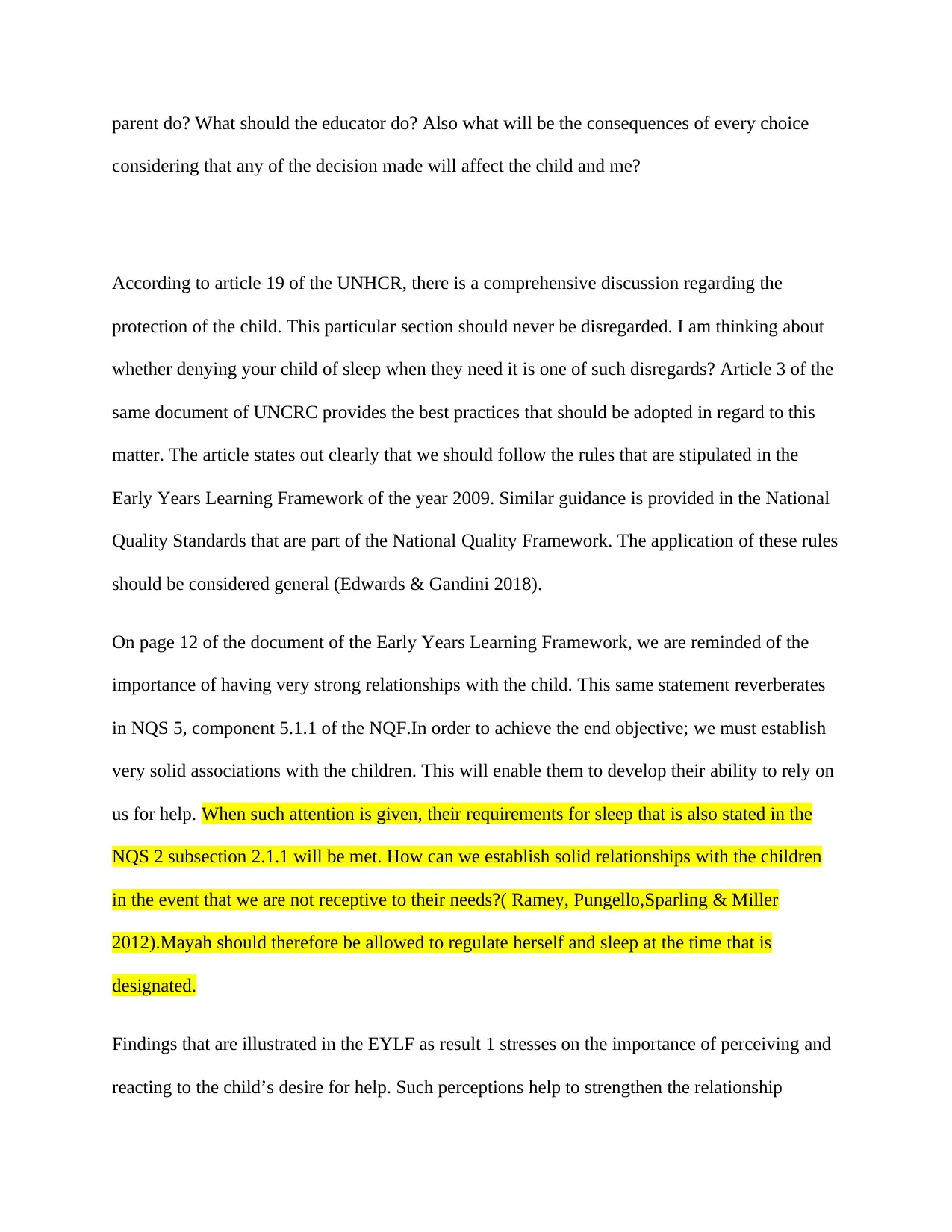
parent do? What should the educator do? Also what will be the consequences of every choice
considering that any of the decision made will affect the child and me?
According to article 19 of the UNHCR, there is a comprehensive discussion regarding the
protection of the child. This particular section should never be disregarded. I am thinking about
whether denying your child of sleep when they need it is one of such disregards? Article 3 of the
same document of UNCRC provides the best practices that should be adopted in regard to this
matter. The article states out clearly that we should follow the rules that are stipulated in the
Early Years Learning Framework of the year 2009. Similar guidance is provided in the National
Quality Standards that are part of the National Quality Framework. The application of these rules
should be considered general (Edwards & Gandini 2018).
On page 12 of the document of the Early Years Learning Framework, we are reminded of the
importance of having very strong relationships with the child. This same statement reverberates
in NQS 5, component 5.1.1 of the NQF.In order to achieve the end objective; we must establish
very solid associations with the children. This will enable them to develop their ability to rely on
us for help. When such attention is given, their requirements for sleep that is also stated in the
NQS 2 subsection 2.1.1 will be met. How can we establish solid relationships with the children
in the event that we are not receptive to their needs?( Ramey, Pungello,Sparling & Miller
2012).Mayah should therefore be allowed to regulate herself and sleep at the time that is
designated.
Findings that are illustrated in the EYLF as result 1 stresses on the importance of perceiving and
reacting to the child’s desire for help. Such perceptions help to strengthen the relationship
considering that any of the decision made will affect the child and me?
According to article 19 of the UNHCR, there is a comprehensive discussion regarding the
protection of the child. This particular section should never be disregarded. I am thinking about
whether denying your child of sleep when they need it is one of such disregards? Article 3 of the
same document of UNCRC provides the best practices that should be adopted in regard to this
matter. The article states out clearly that we should follow the rules that are stipulated in the
Early Years Learning Framework of the year 2009. Similar guidance is provided in the National
Quality Standards that are part of the National Quality Framework. The application of these rules
should be considered general (Edwards & Gandini 2018).
On page 12 of the document of the Early Years Learning Framework, we are reminded of the
importance of having very strong relationships with the child. This same statement reverberates
in NQS 5, component 5.1.1 of the NQF.In order to achieve the end objective; we must establish
very solid associations with the children. This will enable them to develop their ability to rely on
us for help. When such attention is given, their requirements for sleep that is also stated in the
NQS 2 subsection 2.1.1 will be met. How can we establish solid relationships with the children
in the event that we are not receptive to their needs?( Ramey, Pungello,Sparling & Miller
2012).Mayah should therefore be allowed to regulate herself and sleep at the time that is
designated.
Findings that are illustrated in the EYLF as result 1 stresses on the importance of perceiving and
reacting to the child’s desire for help. Such perceptions help to strengthen the relationship
Paraphrase This Document
Need a fresh take? Get an instant paraphrase of this document with our AI Paraphraser
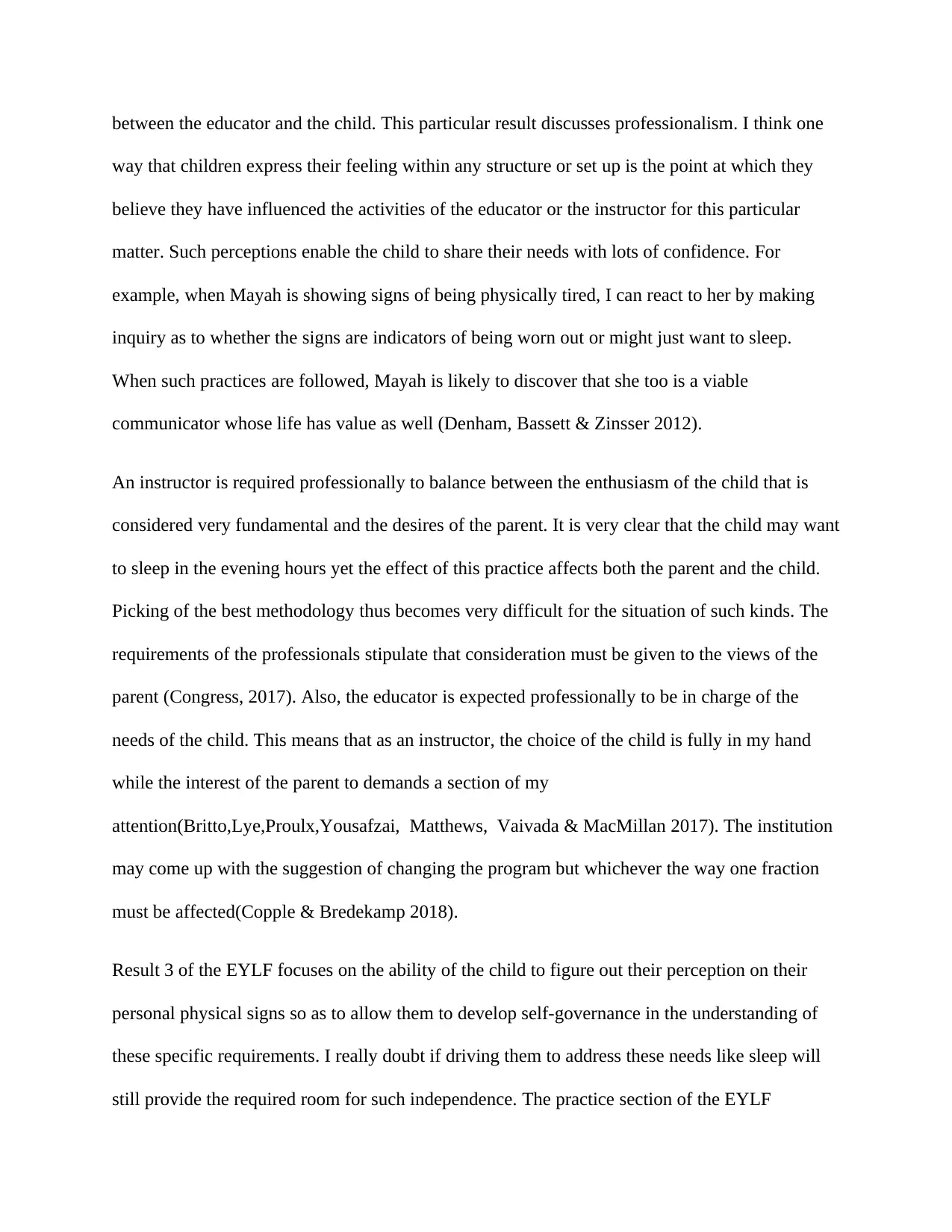
between the educator and the child. This particular result discusses professionalism. I think one
way that children express their feeling within any structure or set up is the point at which they
believe they have influenced the activities of the educator or the instructor for this particular
matter. Such perceptions enable the child to share their needs with lots of confidence. For
example, when Mayah is showing signs of being physically tired, I can react to her by making
inquiry as to whether the signs are indicators of being worn out or might just want to sleep.
When such practices are followed, Mayah is likely to discover that she too is a viable
communicator whose life has value as well (Denham, Bassett & Zinsser 2012).
An instructor is required professionally to balance between the enthusiasm of the child that is
considered very fundamental and the desires of the parent. It is very clear that the child may want
to sleep in the evening hours yet the effect of this practice affects both the parent and the child.
Picking of the best methodology thus becomes very difficult for the situation of such kinds. The
requirements of the professionals stipulate that consideration must be given to the views of the
parent (Congress, 2017). Also, the educator is expected professionally to be in charge of the
needs of the child. This means that as an instructor, the choice of the child is fully in my hand
while the interest of the parent to demands a section of my
attention(Britto,Lye,Proulx,Yousafzai, Matthews, Vaivada & MacMillan 2017). The institution
may come up with the suggestion of changing the program but whichever the way one fraction
must be affected(Copple & Bredekamp 2018).
Result 3 of the EYLF focuses on the ability of the child to figure out their perception on their
personal physical signs so as to allow them to develop self-governance in the understanding of
these specific requirements. I really doubt if driving them to address these needs like sleep will
still provide the required room for such independence. The practice section of the EYLF
way that children express their feeling within any structure or set up is the point at which they
believe they have influenced the activities of the educator or the instructor for this particular
matter. Such perceptions enable the child to share their needs with lots of confidence. For
example, when Mayah is showing signs of being physically tired, I can react to her by making
inquiry as to whether the signs are indicators of being worn out or might just want to sleep.
When such practices are followed, Mayah is likely to discover that she too is a viable
communicator whose life has value as well (Denham, Bassett & Zinsser 2012).
An instructor is required professionally to balance between the enthusiasm of the child that is
considered very fundamental and the desires of the parent. It is very clear that the child may want
to sleep in the evening hours yet the effect of this practice affects both the parent and the child.
Picking of the best methodology thus becomes very difficult for the situation of such kinds. The
requirements of the professionals stipulate that consideration must be given to the views of the
parent (Congress, 2017). Also, the educator is expected professionally to be in charge of the
needs of the child. This means that as an instructor, the choice of the child is fully in my hand
while the interest of the parent to demands a section of my
attention(Britto,Lye,Proulx,Yousafzai, Matthews, Vaivada & MacMillan 2017). The institution
may come up with the suggestion of changing the program but whichever the way one fraction
must be affected(Copple & Bredekamp 2018).
Result 3 of the EYLF focuses on the ability of the child to figure out their perception on their
personal physical signs so as to allow them to develop self-governance in the understanding of
these specific requirements. I really doubt if driving them to address these needs like sleep will
still provide the required room for such independence. The practice section of the EYLF
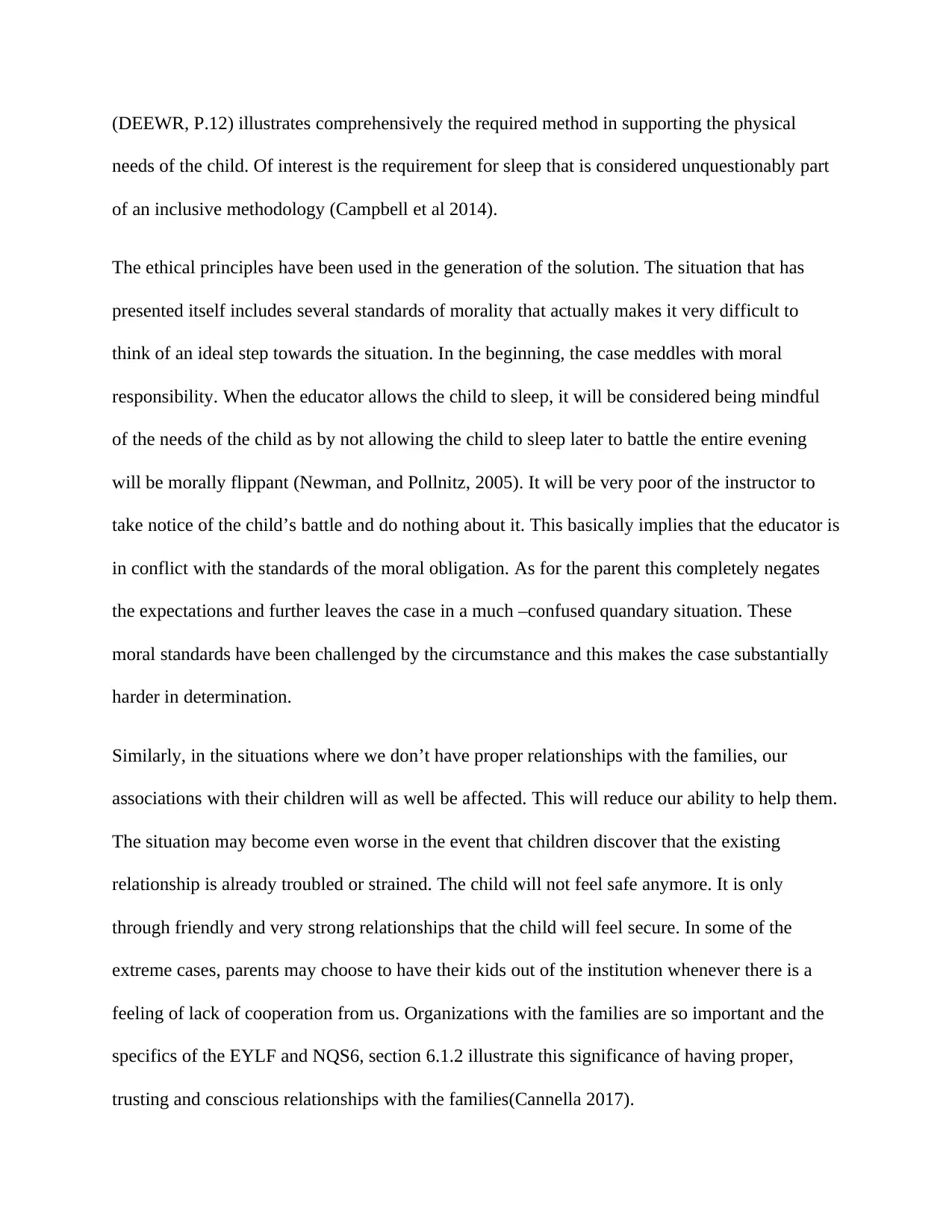
(DEEWR, P.12) illustrates comprehensively the required method in supporting the physical
needs of the child. Of interest is the requirement for sleep that is considered unquestionably part
of an inclusive methodology (Campbell et al 2014).
The ethical principles have been used in the generation of the solution. The situation that has
presented itself includes several standards of morality that actually makes it very difficult to
think of an ideal step towards the situation. In the beginning, the case meddles with moral
responsibility. When the educator allows the child to sleep, it will be considered being mindful
of the needs of the child as by not allowing the child to sleep later to battle the entire evening
will be morally flippant (Newman, and Pollnitz, 2005). It will be very poor of the instructor to
take notice of the child’s battle and do nothing about it. This basically implies that the educator is
in conflict with the standards of the moral obligation. As for the parent this completely negates
the expectations and further leaves the case in a much –confused quandary situation. These
moral standards have been challenged by the circumstance and this makes the case substantially
harder in determination.
Similarly, in the situations where we don’t have proper relationships with the families, our
associations with their children will as well be affected. This will reduce our ability to help them.
The situation may become even worse in the event that children discover that the existing
relationship is already troubled or strained. The child will not feel safe anymore. It is only
through friendly and very strong relationships that the child will feel secure. In some of the
extreme cases, parents may choose to have their kids out of the institution whenever there is a
feeling of lack of cooperation from us. Organizations with the families are so important and the
specifics of the EYLF and NQS6, section 6.1.2 illustrate this significance of having proper,
trusting and conscious relationships with the families(Cannella 2017).
needs of the child. Of interest is the requirement for sleep that is considered unquestionably part
of an inclusive methodology (Campbell et al 2014).
The ethical principles have been used in the generation of the solution. The situation that has
presented itself includes several standards of morality that actually makes it very difficult to
think of an ideal step towards the situation. In the beginning, the case meddles with moral
responsibility. When the educator allows the child to sleep, it will be considered being mindful
of the needs of the child as by not allowing the child to sleep later to battle the entire evening
will be morally flippant (Newman, and Pollnitz, 2005). It will be very poor of the instructor to
take notice of the child’s battle and do nothing about it. This basically implies that the educator is
in conflict with the standards of the moral obligation. As for the parent this completely negates
the expectations and further leaves the case in a much –confused quandary situation. These
moral standards have been challenged by the circumstance and this makes the case substantially
harder in determination.
Similarly, in the situations where we don’t have proper relationships with the families, our
associations with their children will as well be affected. This will reduce our ability to help them.
The situation may become even worse in the event that children discover that the existing
relationship is already troubled or strained. The child will not feel safe anymore. It is only
through friendly and very strong relationships that the child will feel secure. In some of the
extreme cases, parents may choose to have their kids out of the institution whenever there is a
feeling of lack of cooperation from us. Organizations with the families are so important and the
specifics of the EYLF and NQS6, section 6.1.2 illustrate this significance of having proper,
trusting and conscious relationships with the families(Cannella 2017).
⊘ This is a preview!⊘
Do you want full access?
Subscribe today to unlock all pages.

Trusted by 1+ million students worldwide
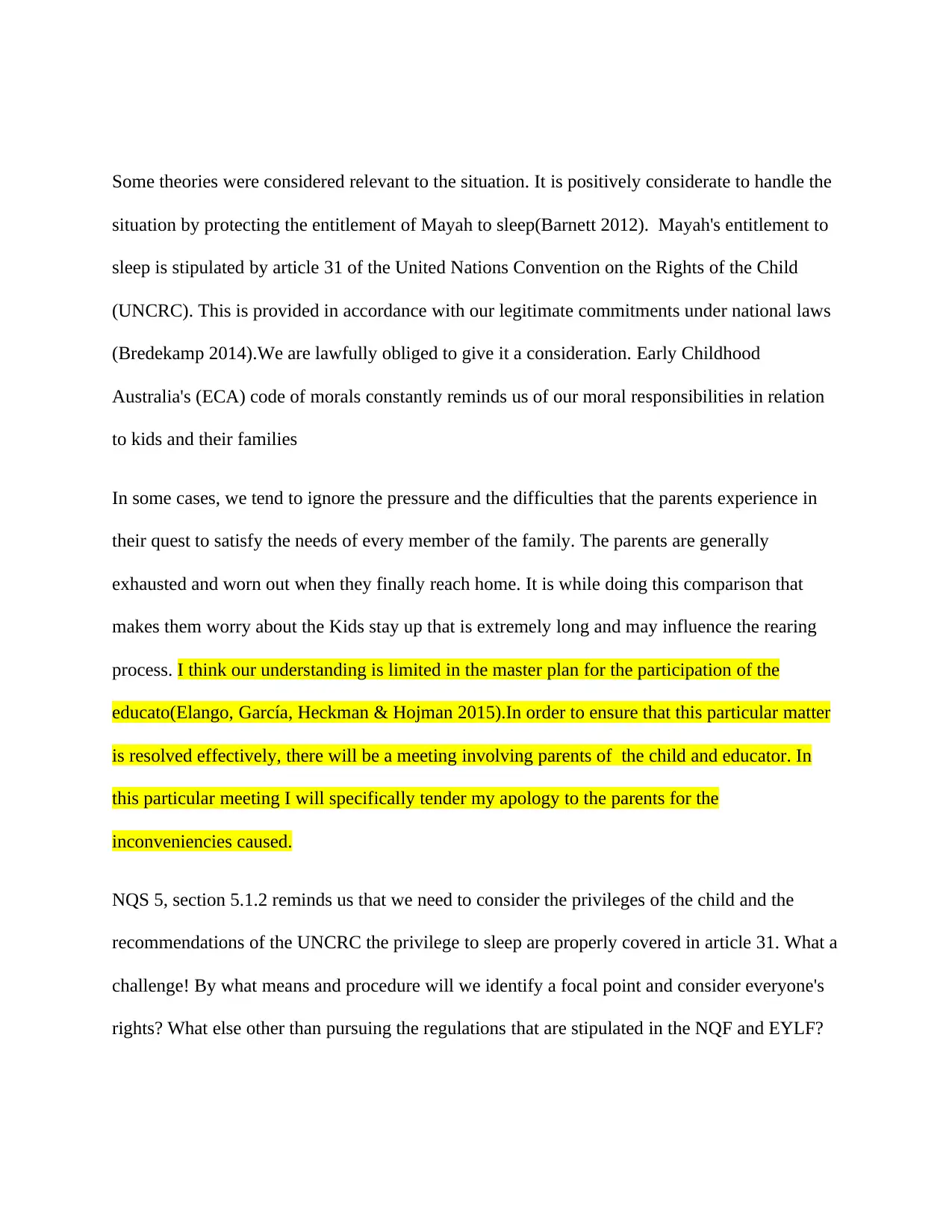
Some theories were considered relevant to the situation. It is positively considerate to handle the
situation by protecting the entitlement of Mayah to sleep(Barnett 2012). Mayah's entitlement to
sleep is stipulated by article 31 of the United Nations Convention on the Rights of the Child
(UNCRC). This is provided in accordance with our legitimate commitments under national laws
(Bredekamp 2014).We are lawfully obliged to give it a consideration. Early Childhood
Australia's (ECA) code of morals constantly reminds us of our moral responsibilities in relation
to kids and their families
In some cases, we tend to ignore the pressure and the difficulties that the parents experience in
their quest to satisfy the needs of every member of the family. The parents are generally
exhausted and worn out when they finally reach home. It is while doing this comparison that
makes them worry about the Kids stay up that is extremely long and may influence the rearing
process. I think our understanding is limited in the master plan for the participation of the
educato(Elango, García, Heckman & Hojman 2015).In order to ensure that this particular matter
is resolved effectively, there will be a meeting involving parents of the child and educator. In
this particular meeting I will specifically tender my apology to the parents for the
inconveniencies caused.
NQS 5, section 5.1.2 reminds us that we need to consider the privileges of the child and the
recommendations of the UNCRC the privilege to sleep are properly covered in article 31. What a
challenge! By what means and procedure will we identify a focal point and consider everyone's
rights? What else other than pursuing the regulations that are stipulated in the NQF and EYLF?
situation by protecting the entitlement of Mayah to sleep(Barnett 2012). Mayah's entitlement to
sleep is stipulated by article 31 of the United Nations Convention on the Rights of the Child
(UNCRC). This is provided in accordance with our legitimate commitments under national laws
(Bredekamp 2014).We are lawfully obliged to give it a consideration. Early Childhood
Australia's (ECA) code of morals constantly reminds us of our moral responsibilities in relation
to kids and their families
In some cases, we tend to ignore the pressure and the difficulties that the parents experience in
their quest to satisfy the needs of every member of the family. The parents are generally
exhausted and worn out when they finally reach home. It is while doing this comparison that
makes them worry about the Kids stay up that is extremely long and may influence the rearing
process. I think our understanding is limited in the master plan for the participation of the
educato(Elango, García, Heckman & Hojman 2015).In order to ensure that this particular matter
is resolved effectively, there will be a meeting involving parents of the child and educator. In
this particular meeting I will specifically tender my apology to the parents for the
inconveniencies caused.
NQS 5, section 5.1.2 reminds us that we need to consider the privileges of the child and the
recommendations of the UNCRC the privilege to sleep are properly covered in article 31. What a
challenge! By what means and procedure will we identify a focal point and consider everyone's
rights? What else other than pursuing the regulations that are stipulated in the NQF and EYLF?
Paraphrase This Document
Need a fresh take? Get an instant paraphrase of this document with our AI Paraphraser
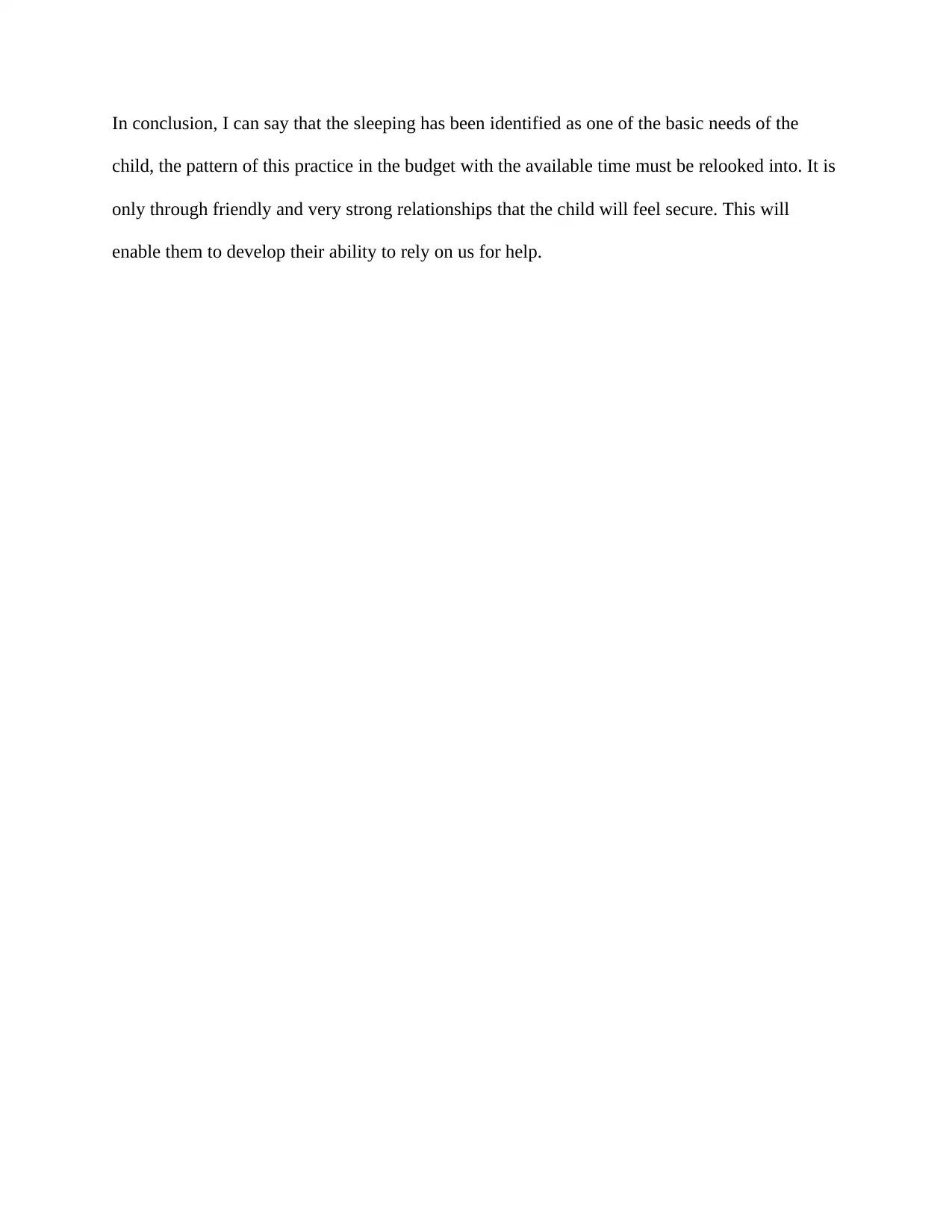
In conclusion, I can say that the sleeping has been identified as one of the basic needs of the
child, the pattern of this practice in the budget with the available time must be relooked into. It is
only through friendly and very strong relationships that the child will feel secure. This will
enable them to develop their ability to rely on us for help.
child, the pattern of this practice in the budget with the available time must be relooked into. It is
only through friendly and very strong relationships that the child will feel secure. This will
enable them to develop their ability to rely on us for help.
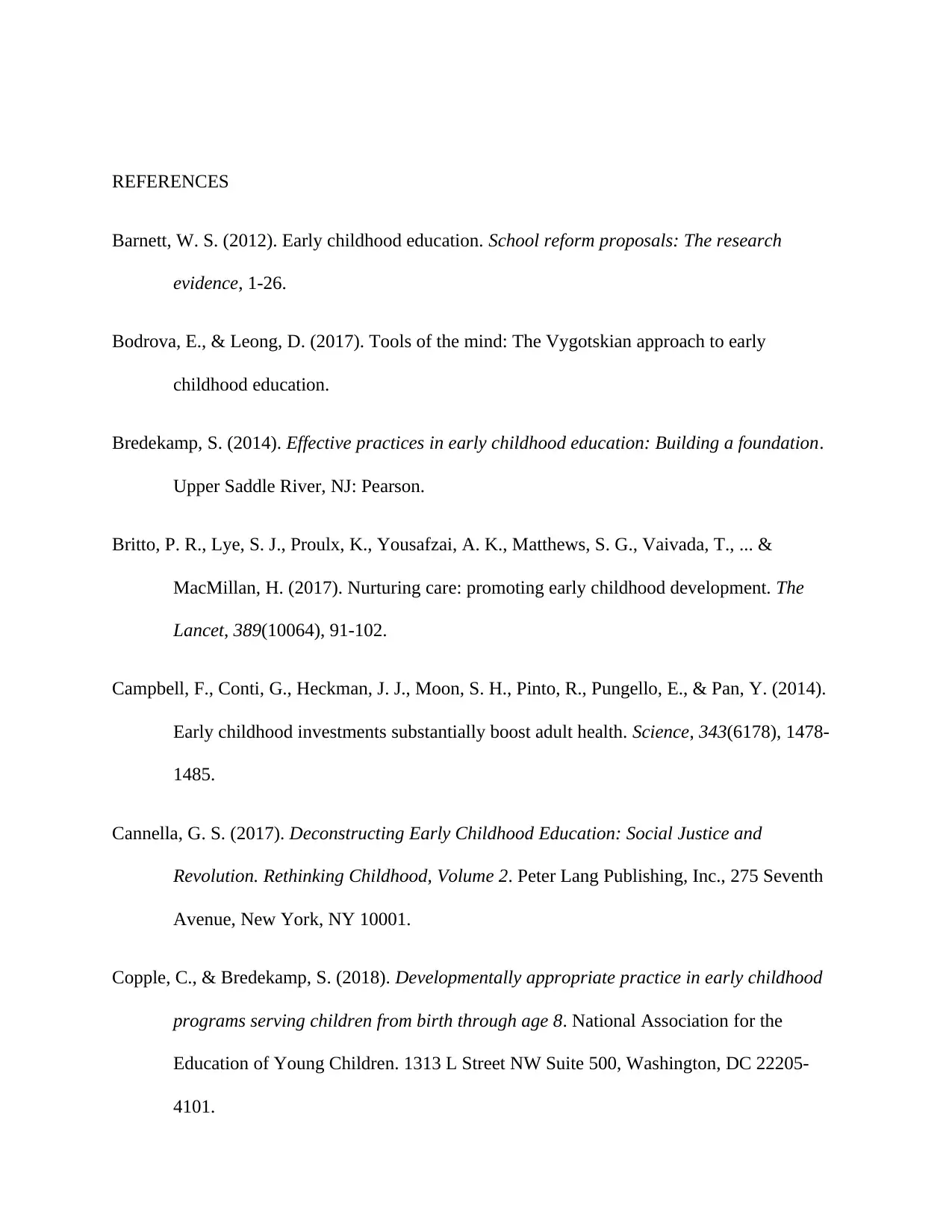
REFERENCES
Barnett, W. S. (2012). Early childhood education. School reform proposals: The research
evidence, 1-26.
Bodrova, E., & Leong, D. (2017). Tools of the mind: The Vygotskian approach to early
childhood education.
Bredekamp, S. (2014). Effective practices in early childhood education: Building a foundation.
Upper Saddle River, NJ: Pearson.
Britto, P. R., Lye, S. J., Proulx, K., Yousafzai, A. K., Matthews, S. G., Vaivada, T., ... &
MacMillan, H. (2017). Nurturing care: promoting early childhood development. The
Lancet, 389(10064), 91-102.
Campbell, F., Conti, G., Heckman, J. J., Moon, S. H., Pinto, R., Pungello, E., & Pan, Y. (2014).
Early childhood investments substantially boost adult health. Science, 343(6178), 1478-
1485.
Cannella, G. S. (2017). Deconstructing Early Childhood Education: Social Justice and
Revolution. Rethinking Childhood, Volume 2. Peter Lang Publishing, Inc., 275 Seventh
Avenue, New York, NY 10001.
Copple, C., & Bredekamp, S. (2018). Developmentally appropriate practice in early childhood
programs serving children from birth through age 8. National Association for the
Education of Young Children. 1313 L Street NW Suite 500, Washington, DC 22205-
4101.
Barnett, W. S. (2012). Early childhood education. School reform proposals: The research
evidence, 1-26.
Bodrova, E., & Leong, D. (2017). Tools of the mind: The Vygotskian approach to early
childhood education.
Bredekamp, S. (2014). Effective practices in early childhood education: Building a foundation.
Upper Saddle River, NJ: Pearson.
Britto, P. R., Lye, S. J., Proulx, K., Yousafzai, A. K., Matthews, S. G., Vaivada, T., ... &
MacMillan, H. (2017). Nurturing care: promoting early childhood development. The
Lancet, 389(10064), 91-102.
Campbell, F., Conti, G., Heckman, J. J., Moon, S. H., Pinto, R., Pungello, E., & Pan, Y. (2014).
Early childhood investments substantially boost adult health. Science, 343(6178), 1478-
1485.
Cannella, G. S. (2017). Deconstructing Early Childhood Education: Social Justice and
Revolution. Rethinking Childhood, Volume 2. Peter Lang Publishing, Inc., 275 Seventh
Avenue, New York, NY 10001.
Copple, C., & Bredekamp, S. (2018). Developmentally appropriate practice in early childhood
programs serving children from birth through age 8. National Association for the
Education of Young Children. 1313 L Street NW Suite 500, Washington, DC 22205-
4101.
⊘ This is a preview!⊘
Do you want full access?
Subscribe today to unlock all pages.

Trusted by 1+ million students worldwide
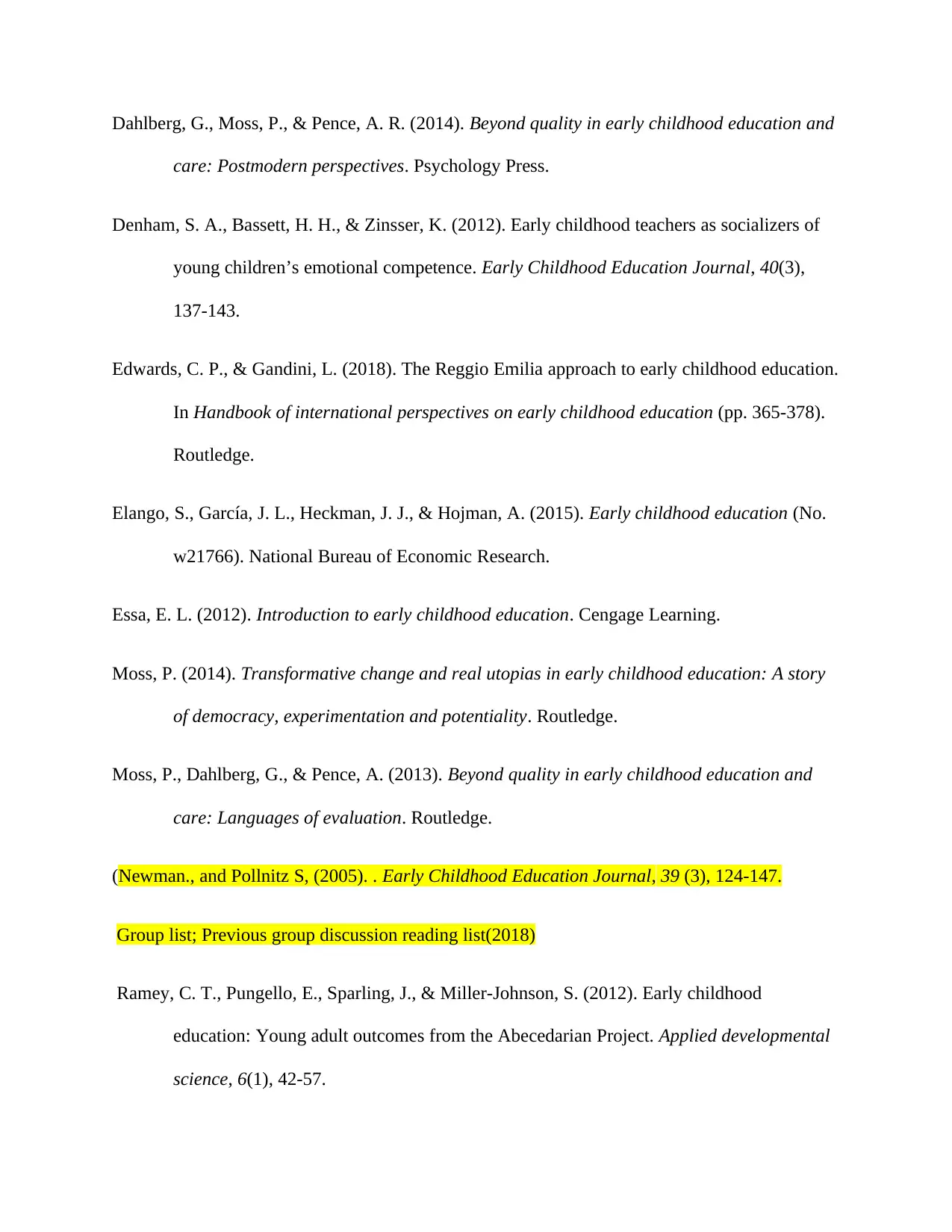
Dahlberg, G., Moss, P., & Pence, A. R. (2014). Beyond quality in early childhood education and
care: Postmodern perspectives. Psychology Press.
Denham, S. A., Bassett, H. H., & Zinsser, K. (2012). Early childhood teachers as socializers of
young children’s emotional competence. Early Childhood Education Journal, 40(3),
137-143.
Edwards, C. P., & Gandini, L. (2018). The Reggio Emilia approach to early childhood education.
In Handbook of international perspectives on early childhood education (pp. 365-378).
Routledge.
Elango, S., García, J. L., Heckman, J. J., & Hojman, A. (2015). Early childhood education (No.
w21766). National Bureau of Economic Research.
Essa, E. L. (2012). Introduction to early childhood education. Cengage Learning.
Moss, P. (2014). Transformative change and real utopias in early childhood education: A story
of democracy, experimentation and potentiality. Routledge.
Moss, P., Dahlberg, G., & Pence, A. (2013). Beyond quality in early childhood education and
care: Languages of evaluation. Routledge.
(Newman., and Pollnitz S, (2005). . Early Childhood Education Journal, 39 (3), 124-147.
Group list; Previous group discussion reading list(2018)
Ramey, C. T., Pungello, E., Sparling, J., & Miller-Johnson, S. (2012). Early childhood
education: Young adult outcomes from the Abecedarian Project. Applied developmental
science, 6(1), 42-57.
care: Postmodern perspectives. Psychology Press.
Denham, S. A., Bassett, H. H., & Zinsser, K. (2012). Early childhood teachers as socializers of
young children’s emotional competence. Early Childhood Education Journal, 40(3),
137-143.
Edwards, C. P., & Gandini, L. (2018). The Reggio Emilia approach to early childhood education.
In Handbook of international perspectives on early childhood education (pp. 365-378).
Routledge.
Elango, S., García, J. L., Heckman, J. J., & Hojman, A. (2015). Early childhood education (No.
w21766). National Bureau of Economic Research.
Essa, E. L. (2012). Introduction to early childhood education. Cengage Learning.
Moss, P. (2014). Transformative change and real utopias in early childhood education: A story
of democracy, experimentation and potentiality. Routledge.
Moss, P., Dahlberg, G., & Pence, A. (2013). Beyond quality in early childhood education and
care: Languages of evaluation. Routledge.
(Newman., and Pollnitz S, (2005). . Early Childhood Education Journal, 39 (3), 124-147.
Group list; Previous group discussion reading list(2018)
Ramey, C. T., Pungello, E., Sparling, J., & Miller-Johnson, S. (2012). Early childhood
education: Young adult outcomes from the Abecedarian Project. Applied developmental
science, 6(1), 42-57.
Paraphrase This Document
Need a fresh take? Get an instant paraphrase of this document with our AI Paraphraser
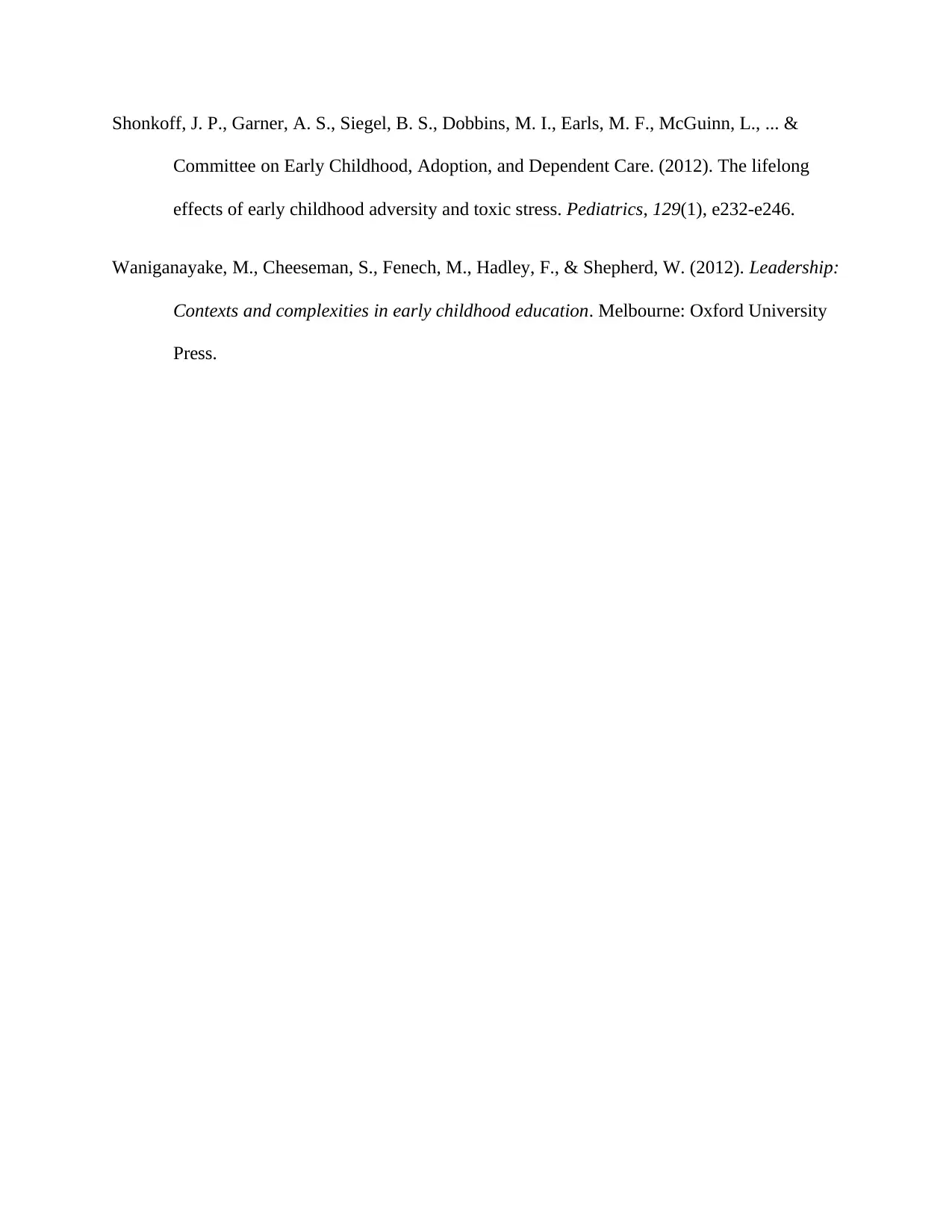
Shonkoff, J. P., Garner, A. S., Siegel, B. S., Dobbins, M. I., Earls, M. F., McGuinn, L., ... &
Committee on Early Childhood, Adoption, and Dependent Care. (2012). The lifelong
effects of early childhood adversity and toxic stress. Pediatrics, 129(1), e232-e246.
Waniganayake, M., Cheeseman, S., Fenech, M., Hadley, F., & Shepherd, W. (2012). Leadership:
Contexts and complexities in early childhood education. Melbourne: Oxford University
Press.
Committee on Early Childhood, Adoption, and Dependent Care. (2012). The lifelong
effects of early childhood adversity and toxic stress. Pediatrics, 129(1), e232-e246.
Waniganayake, M., Cheeseman, S., Fenech, M., Hadley, F., & Shepherd, W. (2012). Leadership:
Contexts and complexities in early childhood education. Melbourne: Oxford University
Press.
1 out of 11
Your All-in-One AI-Powered Toolkit for Academic Success.
+13062052269
info@desklib.com
Available 24*7 on WhatsApp / Email
![[object Object]](/_next/static/media/star-bottom.7253800d.svg)
Unlock your academic potential
Copyright © 2020–2025 A2Z Services. All Rights Reserved. Developed and managed by ZUCOL.


